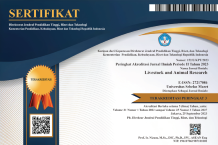The success rate of artificial insemination in Limousin crossbred heifer with additional concentrate
Abstract
Objective: This study aimed to determine whether the addition of concentrate to heifers could be the same as the success of AI in calving cows in terms of Return Rate (NRR), Conception Rate (CR), and Pregnancy Rate (PR).
Methods: The material used in this study was 28 Limousine Crossbred cows with 13 cows and 15 heifers. There were two treatments, namely T0: Cows that had given birth with control feed (control without added concentrate) + BIO ATP after AI, while T1: Heifers with control feed and the addition of 1kg/day concentrate for seven days after AI + BIO ATP. Samples were selected by purposive sampling with the criteria of BCS 3-5 (1-9) and aged ≥ 2 years. The artificial insemination method uses rectovaginal with 4+ deposition at the 2nd and 8th hour after estrus, then injection of Bio ATP brand "Rheinbio" intramuscularly as much as 10 ml.
Results: The results showed that the reproductive performance of Limousine Crossbred Cow that had given birth (T0) was NRR1 84.62%, NRR2 84.62%, CR 53.33%, and PR 66.67%, while in heifers (T1), it was NRR1 86 .67%, NRR2 60%, CR 20%, and PR 20%.
Conclusions: The addition of concentrate feed of 1 kg/head/day for seven days before AI in heifers (T1) showed lower reproductive success than in cows that had given birth (T0) even without the addition of concentrate.
Keywords
Full Text:
PDFReferences
- BPS. 2021. Statistik peternakan dan kesehatan hewan. Kementerian Pertanian Direktorat Jenderal Peternakan dan Kesehatan Hewan, Jakarta.
- Ihsan, M. N. and S. Wahjuningsih. 2011. Penampilan reproduksi sapi potong di Kabupaten Bojonegoro. Jurnal Ternak Tropika. 12:76-80.
- Wahyudi, L., T. Susilawati and N. Isnaini. 2014. Tampilan reproduksi hasil inseminasi buatan menggunakan semen beku hasil sexing pada sapi Persilangan Ongole di peternakan rakyat. Jurnal Ternak Tropika. 15:80-88.
- Inchaisri, C., R. Jorritsma, J. C. M. Vernooij, P. Vos, G. C. V. D. Weijden, and H. Hogeveen. 2011. Cow effects and estimation of success ff first and following inseminations in dutch dairy cows. Reproduction in Domestic Animals. 46:1043-1049. Doi: 10.1111/j.1439-0531.-2011.01782.x
- Annashru, F. A., M. N. Ihsan, A. P. A. Yekti, and T. Susilawati. 2017. Pengaruh perbedaan waktu inseminasi buatan terhadap keberhasilan kebuntingan sapi Brahman Cross. Jurnal Ilmu-Ilmu Peternakan. 27:17-23. Doi: 10.21776/ub.-jiip.2017.027.03.03
- Zainudin, Z., M. N. Ihsan and S. Suyadi. 2015. Efisiensi reproduksi sapi perah PFH pada berbagai umur di CV. Milkindo berka abadi desa tegalsari kecamatan kepanjen kabupaten malang. Jurnal Ilmu-Imu Peternakan. 24:32-37.
- Baco, S., M. Yusuf, B. Wello, and M. Hatta. 2013. Current status of reproductive management in bali cows in South Sulawesi Province, Indonesia. Open Journal of Forestry. 3:4-6. Doi: 10.4236/ojf.2013.34B002
- Feradis, M. P. 2010. Reproduksi ternak. Alfabeta, Bandung.
- Bindari, Y. R., S. Shrestha, N. Shrestha, and T. N. Gaire. 2013. Effects of nutrition on reproduction-a review. Adv. Appl. Sci. Res. 4:421-429.
- Malda, Y., N. Layla, A. P. A. Yekti., A. N. Huda, and T. Susilawati. Pengaruh pemberian konsentrat pada waktu yang berbeda terhadap keberhasilan inseminasi buatan pada sapi Persilangan Limousin. Lives. Anim. Res. 20:243-250. Doi: 10.20961/lar.v20i3.58662
- Susilawati, T. 2011. Tingkat keberhasilan inseminasi buatan dengan kualitas dan deposisi semen yang berbeda pada sapi Peranakan Ongole. Jurnal Ternak Tropika. 12:15-24.
- Jainudeen, M. R. and E. S. E. Hafez. 2000. Cattle and buffalo in reproduction in farm animals ed by E.S.E. Hafez and B. Hafez. Blackwell Publishing, USA.
- Wiranto, W., K. Kuswati, R. Prafitri, A. N. Huda, A. P. A. Yekti., dan T. Susilawati. 2020. Tingkat keberhasilan inseminasi buatan menggunakan semen beku sexing pada bangsa sapi yang berbeda. Jurnal Agripet. 20:17-21. Doi: 10.17969/agripet.-v20i1.15811
- Jaśkowski, J. M, M. Kaczmarowsk, J. Kulus, B. M. Jaśkowski, M. Herudzińska, and M. Gehrke. 2019. Rectal palpation for pregnancy in cows: a relic or an alternative to modern diagnostic methods. Medycyna Weterynaryjna. 75:259–264. Doi: 10.21521-/mw.6156
- Lestari, T. D. and I. Ismudiono. 2014. Ilmu reproduksi ternak. Airlangga University Press, Surabaya.
- Rosita, E. A., T. Susilawati, and S. Wahjuningsih. 2013. Keberhasilan IB menggunakan semen beku hasil sexing dengan metode sedimentasi putih telur pada sapi PO Cross. Jurnal Ilmu-Ilmu Peternakan. 24: 72-76.
- Borchardt, S, L. Schüller, L. Wolf, C. Wesenauer, and W. Heuwieser. 2018. Comparison of pregnancy outcomes using either an ovsynch or a cosynch protocol for the first timed ai with liquid or frozen semen in lactating dairy cows. Theriogenology. 107:21-26. Doi: 10.1016/j.-theriogenology.2017.10.026
- Handayanta, E., K. Lutojo, and N. Nurdiati. 2017. Efisiensi produksi sapi potong pada peternakan rakyat pada musim kemarau di daerah pertanian lahan kering Kabupaten Gunung Kidul. Journal of Sustainable Agriculture. 32:49-54. Doi: 10.20961/carakatani.v32i1.15928
- Yanuartono, P. H., A. Nururrozi, and S. Indarjulianto. 2017. Saponin: dampak terhadap ternak (ulasan) saponin: impact on livestock (a review). Jurnal Peternak Sriwijaya. 6:79-90. Doi: 10.33230/JPS.6.2.-2017.5083
- Olson, K. C., E. Bailey, Z. Duncan, and W. Swecker. 2021. Nutrition and reproduction in the beef cow. Wiley. 372-387. Doi: 10.1002/9781119602484.ch31
- Mondragon, V., C. S. Galina, I. Rubio, M. Corro, and F. Salmerón. 2016. Effect of restricted suckling on the onset of follicular dynamics and body condition score in brahman cattle raised under tropical conditions. Anim. Reprod. Sci. 167:89-95. Doi: 10.1016/j.anireprosci.2016.02.011
- Gaude, I., A. Kempf, K. D. Strüve, and M. Hoedemaker. 2021. Estrus signs in holstein friesian dairy cows and their reliability for ovulation detection in the context of visual estrus detection. Lives. Scie. 245:1-6. Doi: 10.1016/j.livsci.2021.104449
- Yekti, A. P. A., T. Susilawati, M. N. Ihsan, and S. Wahjuningsih. 2017. Fisiologi reproduksi ternak. Universitas Brawijaya Press, Malang.
- Rohayati, T. and R. F. Christi. 2017. Penampilan reproduksi sapi Peranakan Ongole dara. Jurnal Ilmu Peternakan. 1:7-14. Doi: 10.52434/janhus.v1i2.241
- Budiyanto, A., T. T. Tophianong, and D. H. Triguntoro. 2016. Bali cattle reproductive disorders of semi intensive management in the area of cattle oil palm integration system. Acta Vet. Indones. 4:14-18.
- Utami, P., M. Z. Hanif, A. P. A. Yekti, R. Prafitri, A. N. Huda, K. Kuswati, and T. Susilawati. 2022. Evaluation the success of artificial insemination using frozen sexed semen based on different estrus characters. Jurnal Agripet. 22:190-196. Doi: 10.17969/agripet.v22i2.23423
- Masruro, N. V. A., S. Mulyani, N. Harijani, S. P. Madyawati, A. Samik, and H. Ratnani. 2020. Penggunaan kombinasi gonadotropin untuk pengobatan hipofungsi ovarium pada sapi perah. Ovozoa. 9:23-27. Doi: 10.20473/ovz.v9i1.-2020.23-27
- Suartini, N. K., G. H. B. Trilaksana, and T. G. O. Pemayun. 2013. Kadar estrogen dan munculnya estrus setelah pemberian Buserelin (Agonis GnRH) pada sapi Bali yang mengalami anestrus postpartum akibat hipofungsi ovarium. Jurnal Ilmu Dan Kesehatan Hewan. 1:40-44.
- Utami, P., M. Z. Hanif, A. P. A. Yekti, J. Riyanto, C. Hanim, and T. Susilawati. 2022. The relationship of estrus character before double dose artificial insemination in limousin crossbred cow. E3S Web Conf. 335:1-9. Doi: 10.1051/e3sconf/202233500031
- Gucht, V. D. T., W. Saeys, A. V. Nuffel, L. Pluym, K. Piccart, L. Lauwers, J. Vangeyte, and S. V. Weyenberg. 2017. Farmers' preferences for automatic lameness-detection systems in dairy cattle. J. Dairy Sci. 100:5746-5757. Doi: 10.3168/jds.2016-12285
- Berdugo-Gutiérrez, J. A., A. Tarazona, J. J. Echeverry, W. D. Cardona-Maya, and A. L. Herrera. 2018. Evaluation of a strategy to incorporate reproductive biotechnologies into buffalo farming without affecting reproductive parameters of the herd: a colombian case. Buffalo Bulletin. 37:59-64.
- Affandhy, L., D. M. Dikman, and D. Ratnawati. 2019. Pengaruh waktu perkawinan pasca beranak terhadap performa produktivitas sapi induk pada kondisi peternakan rakyat. Jurnal Ilmu-Ilmu Peternakan. 29:158-166. Doi: 10.21776/ub.jiip.2019.029.02.07
Refbacks
- There are currently no refbacks.










